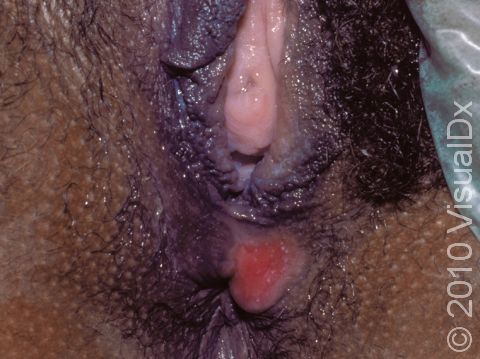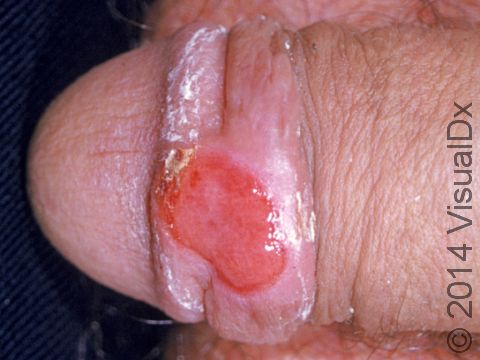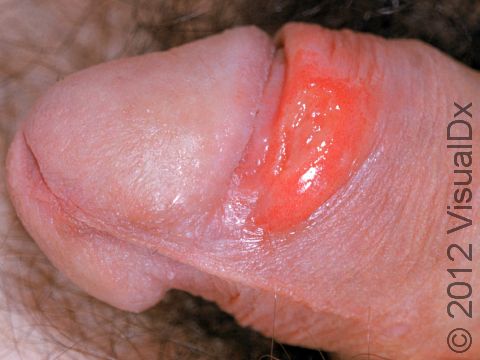Primary Syphilis
Primary syphilis is a disease caused by a corkscrew-shaped bacterium (a spirochete) called Treponema pallidum. It causes disease when it penetrates broken skin of the genitals or the mucous membranes of the mouth or anus. Primary syphilis is usually passed on to others through sexual contact, but other ways are possible (for example, from an infected mother to her newborn baby). There are 3 stages of infection, and it is important to recognize infection in the first (primary) stage, as this stage will heal without therapy. If the infection is not treated early, it will then continue and often goes on to damage the nervous system and the heart, leading to early death.
Syphilis can be completely cured if treated early. Healed infection leaves no immunity, so you can get infected again.
Who's At Risk?
Syphilis occurs worldwide. In the US, the rates of disease are higher in urban areas and the Southern states. Young adults (aged 15–25) are the highest-risk group for syphilis.
Syphilis is more common in men who have sex with men, sex workers, and people exposed to sex workers; this accounts for the fact that syphilis is seen more commonly in men than women.
Signs & Symptoms
Initially, in syphilis, a dusky red flat spot appears at the site of inoculation and is easily missed. Then, a painless ulcer (chancre) appears 18–21 days after initial infection. Genital sites in women affected are the cervix, vagina, vulva, and clitoris. Cervical and vaginal syphilis infections may not be recognized. In men, the chancre is easily seen on the penis. Other locations of infection are limited only by human ingenuity and imagination. Common sites are around the mouth (perioral) and between the buttocks (perianal) areas.
Chancres vary in size from a few millimeters to several centimeters. A chancre is usually painless, solitary, and shallow, with a sharp border and raised, hard edge. About 70–80% of patients have rubbery, non-tender, swollen lymph nodes, often on only one side of the groin, during the first week of infection.
If untreated, the chancre will remain present for 1–6 weeks. If treated, it heals without scarring in 1–2 weeks.
Self-Care Guidelines
Syphilis, in the primary stage, is highly contagious and can heal without therapy, making it easy to be mistaken for something less serious. If you are sexually active and suspect you have been exposed to syphilis or have an ulcer in the mouth, genital area, or anal area, you should seek medical care immediately. You should avoid any further sexual activity and notify any previous sexual partners.
Syphilis can be prevented by abstaining from casual sexual activity and using condoms correctly during any sexual contact. If you are in a long-term relationship, make sure that you know your partner’s sexual history or ask that your partner is tested prior to engaging in sexual activity.
Treatments
Blood and fluid tests will be done to look for other infectious sexually transmitted diseases that are often present along with syphilis.
Antibiotics (penicillin, doxycycline, or tetracycline) will be given, and blood tests will be done again; you will be followed for 2 years to be sure the infection is gone.
Do not engage in sexual activity until the chancre is healed and follow-up blood tests have shown that the infection has been cured.
Visit Urgency
See your doctor immediately:
- If you are sexually active and have any ulcer in the genital, mouth, or anal area or suspect you have been exposed to someone with syphilis. Meantime, avoid sexual activity and notify your sexual partner(s) of your illness.
- If you have had intimate contact with someone with syphilis, have been using intravenous drugs, or if you have engaged in sex with multiple or unknown partners.
Trusted Links
References
>Bolognia, Jean L., ed. Dermatology, pp.1271-1282. New York: Mosby, 2003.
Freedberg, Irwin M., ed. Fitzpatrick’s Dermatology in General Medicine. 6th ed. pp.1263, 2164-2165. New York: McGraw-Hill, 2003.
Last modified on October 10th, 2022 at 7:11 pm

Not sure what to look for?
Try our new Rash and Skin Condition Finder


